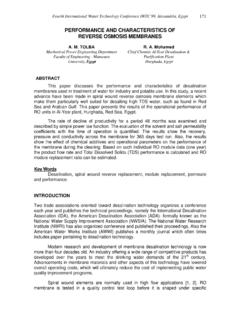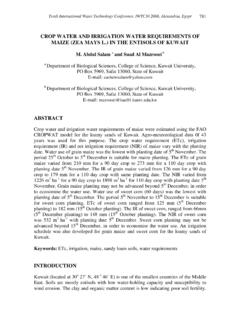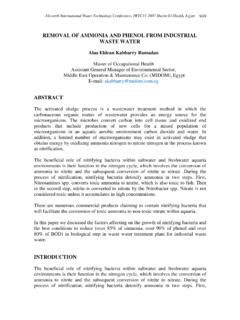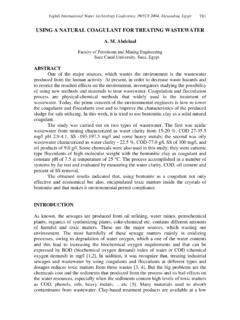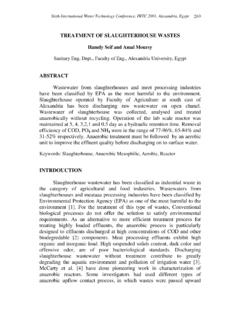Transcription of THE EFFECT OF USING MICROORGANISMS ON …
1 Fourteenth International Water Technology Conference, IWTC 14 2010, Cairo, Egypt 459 THE EFFECT OF USING MICROORGANISMS ON sludge reduction IN wastewater treatment PLANT A. Nasr Dr., Dept. of Environmental Engineering, Faculty of Engineering, Zagazig University, El-Zagazig, Egypt E-mail: ABSTRACT sludge dewatering and treatment may cost as much as the wastewater treatment . Usually large proportion of the pollutants in wastewater is organic. They are attacked by saprophytic MICROORGANISMS , , organisms that feed upon dead organic matter. Activity of organisms causes decomposition of organic matter and destroys them, where the bacteria convert the organic matter or other constituents in the wastewater to new cells, water, gases and other products.
2 The main objective of the present search is to improve an effective way and applicable methods of sludge volume reduction so as to increase the capacity and improve quality of the treatment in lagoon, A bench scale model was set at the environmental engineering department laboratory, in the Faculty of Engineering, Zagazig University. Samples of wastewater were collected from Aslogy wastewater treatment plant, Zagazig, Egypt. The USING bacteria embed on granular delivered as powder. Two runs of experimental works have been done USING bacteria with different doses ( , 1, 2 & 4 gm/l) for up to 8 weeks. Experimental results were indicated that there is no remarkable improvement in COD removal ratio than reference sample in wastewater by adding the used microorganism even at dose of 4 gm/l.
3 However, the sludge volume showed remarkable decrease, due to the use of the bacteria to about 63% more than that of the reference sample. Keywords: Bacteria, COD, sludge volume, Organic mass INTRODUCTION Most treatment systems for domestic sewage depend on a wide array of aerobic and facultative anaerobic MICROORGANISMS , mainly bacteria that can utilize the raw organic material as a carbon and energy source during their growth and reproduction. As a result, these MICROORGANISMS decompose much of the organic fraction into simpler, less-toxic compounds; destroy pathogenic ( , disease-causing) MICROORGANISMS ; stabilized the system by decreasing its volatility; and facilitate the recycling of water for domestic, agricultural and environmental use.
4 wastewater contains various types of Fourteenth International Water Technology Conference, IWTC 14 2010, Cairo, Egypt 460 bacteria, virus, protozoa, algae, fungi etc. Some of these are pathogens and harmful to the human and animal life, (Metcalf & Eddy, Inc. 1995). Otherwise, a factor often overlooked in the selection of a treatment process is the needs of the owner of the facilities. Owner needs may take the form of limitations of cost and the ability to pay for the project. This mean that cost considerations are a major significance in the selection of the wastewater treatment . Horng et al. (2004) made an invention.
5 The primary objective of the invention is to provide a cost-effective apparatus and a workable method of reducing biological wasted sludge so as to improve quality of the treated water. The invention includes subjecting a biological wasted sludge to hydrolysis and neutralization treatments to offer an intermediate feed suitable to be treated in the membrane bioreactor (MBR). The hydrolyzed sludge and MICROORGANISMS are retained in the MBR, so that a further hydrolysis of sludge and decomposition of organics undergo to achieve the objectives of stabilization of sludge and reduction of sludge . Banerjee and Hooda (2005) added specialty MICROORGANISMS to pulp mill aeration stabilization basins able to reduce sludge in-situ.
6 Laboratory work undertaken to identify the machinist showed that a cell-free extract prepared from the MICROORGANISMS decreased the length of pulp fibers that are the principal components of primary sludge . The hemicellulosic components of the fiber degrade upon exposure. A controlled field study was also run in the secondary treatment system of a pulp mill. Primary sludge was held in vials capped with semipermeable membranes that allowed liquid and gas to flow through the vials. Vials containing sludge , to which we added microbes, were placed in the lagoon. No decrease in sludge mass was observed over seven months of exposure to the lagoon water.
7 This proposes that the sludge reduction observed in the field occurs from initial degradation of the fibrous sludge into smaller fragments that are then slowly mineralized. This study helps identify the mechanisms by which specialty organisms are able to break down fibrous sludge in wastewater treatment systems. Wang et al. (2003) aimed to intensify conventional composting of a mixture of sewage sludge and solid food wastes by a one-stage thermophilic bioconversion of these wastes into an organic fertilizer. An intensive process was carried out in a closed system, with or without addition of a starter culture of Bacillus thermoamylovorans.
8 The most effective thermophilic bioconversion of the mixture of food waste and sewage sludge , with addition of starter culture, was when the pH was buffered with calcium carbonate, or the pH drop in the material was prevented by preliminary removal of sulphides from sewage sludge by hydrogen peroxide. The USING of biological additives, like bacteria and extracellular enzymes mixed with surfactants or nutrient solutions, was studied. Some biological additives have been found to degrade or dissipate septic tank scum and sludge , [10]. Some studies suggest that material degraded by additives in the tank contributes to increased loadings of biochemical oxygen demand (BOD), total suspended solids Fourteenth International Water Technology Conference, IWTC 14 2010, Cairo, Egypt 461 (TSS), and other contaminants in the otherwise clarified septic tank effluent.
9 The web site ( ) showed that filamentous bacteria serve as the backbone of floc formation. sludge settles most efficiently when it contains a moderate number of filaments which provide structure for the floc and aid in the stripping of the water column. The floc cannot form properly if there are too few filaments, and the floc cannot settle properly if there are too many. During a nutrient deficiency, the bacteria within the floc particles remove soluble BOD from the wastewater . However, when nitrogen or phosphorous is deficient, the soluble BOD is not degraded but it is stored within the floc particles as an exocellular polymer-like material.
10 This slimy material interferes with settling and may cause foam upon aeration. Bulking is a problem consisting of slow settling and poor compaction of solids in the clarifier of the activated sludge system. Filamentous bulking is usually caused by the excessive growth of filamentous MICROORGANISMS . sludge settleability is determined by measuring the sludge volume index (SVI), which is the ratio of the sludge volume (SV), to the mixed liquor suspended solid (MLSS): MLSSSVgmLSVI1000)( = (1) A high SVI (>150 mL/g) indicates bulking conditions, whereas an SVI below 70 m L/g indicates the predominance of pin (small) floc.
